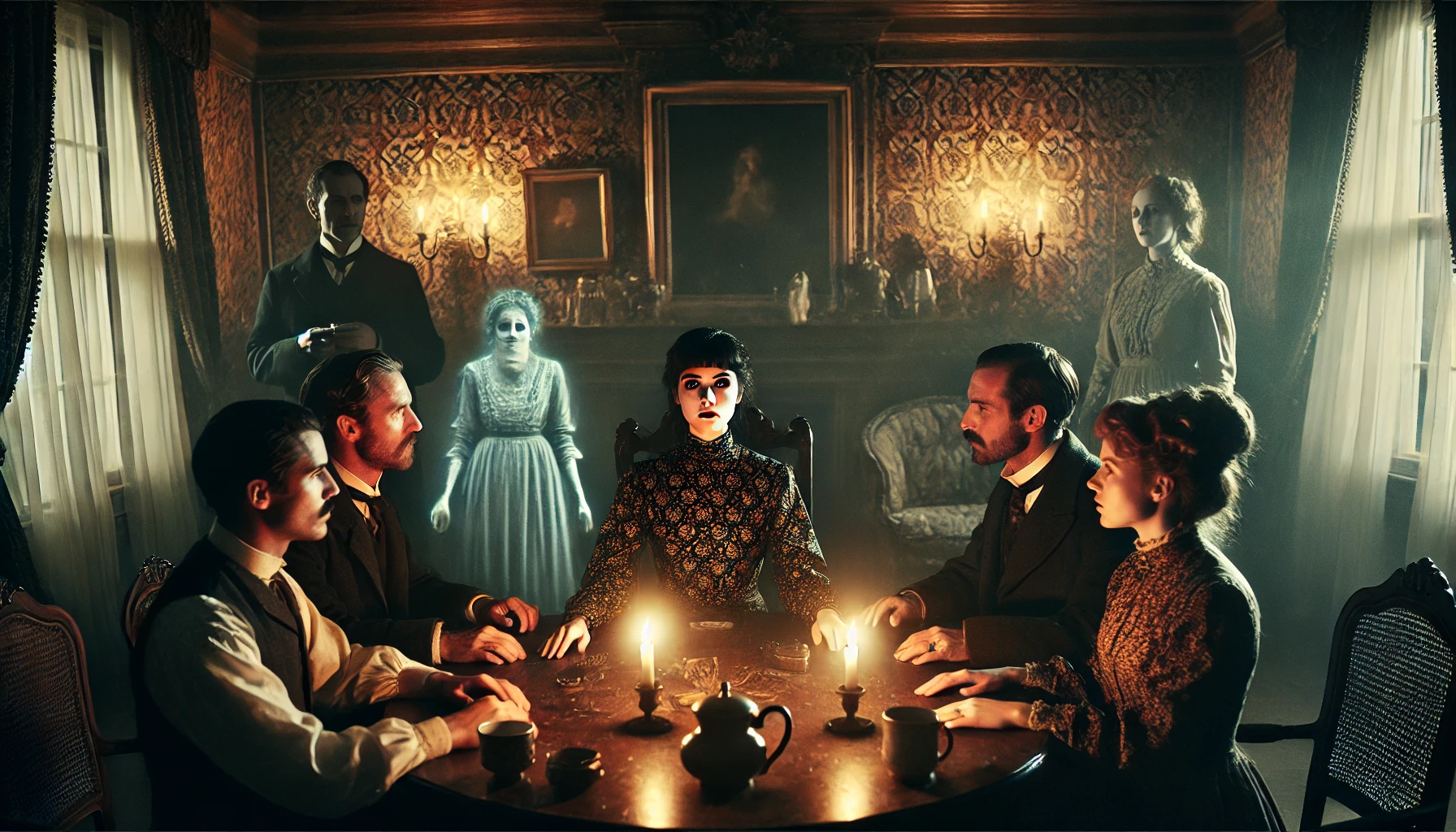The Invisible Girl by Mary Shelley, published in 1820, is a haunting tale set in the early 18th century that weaves romance, mystery, and gothic elements into a gripping narrative. It tells the story of Henry Vernon and his beloved Rosina, whose love is thwarted by societal pressures and familial cruelty. After Rosina mysteriously disappears, presumed dead, Henry is led by a strange light in a desolate tower. There, he uncovers the truth behind Rosina’s fate and the legends surrounding the so-called “Invisible Girl.” Shelley’s atmospheric writing and exploration of love, isolation, and redemption make this a compelling short story.
Plot Summary
In the early 18th century, a solitary tower stood on a bleak promontory overlooking the tumultuous sea between Wales and Ireland. To an outsider, its exterior bore the marks of many a battle with the elements, a rugged fortress against time. Yet inside, it was furnished with an unexpected elegance, as if it were the retreat of some solitary soul seeking respite from the world. Above the fireplace hung a delicate watercolor painting of a young girl, her innocent and serene beauty an enigma in this place of desolation. Below her portrait, inscribed in golden letters, were the words: “The Invisible Girl.”
On a stormy September day, a gentleman named Henry Vernon arrived at a small coastal town not far from this desolate tower. Henry, clad in deep mourning, his face etched with sorrow, sought passage to his family’s mansion further up the coast. Despite the foreboding weather, he convinced two local fishermen to take him out to sea, desperate to reach his destination. As they ventured forth, the sky darkened, and the sea grew wild, tossing their tiny vessel upon the waves. The wind howled and the rain fell in sheets, until they were surrounded by nothing but chaos and the threat of death.
Suddenly, a faint light pierced the darkness. The fishermen, straining their eyes, recognized it as a beacon from the old tower. It was a light they had seen only recently and had come to associate with the “Invisible Girl,” a mysterious figure rumored to haunt the coast. Though wary, they steered toward this beacon, and the light guided them safely to shore. Their relief was palpable as they hauled their boat up the beach and made their way toward the tower, seeking shelter from the storm. Inside, Henry’s thoughts turned inward, toward the haunting memories of his past and the reason for his journey.
Henry Vernon had not always been a man consumed by grief. He was once a carefree young man, the only son of Sir Peter Vernon, who ruled over his estate with a stern and often tyrannical hand. Growing up alongside Henry was Rosina, a sweet and gentle orphan whom Sir Peter had taken in and raised. As children, Henry and Rosina were inseparable, and as they grew, their friendship blossomed into a deep and secret love. They made plans to marry once Henry came of age, but they kept their love hidden, knowing that Sir Peter would never approve.
Their secret was uncovered by Mrs. Bainbridge, Sir Peter’s spiteful sister. She saw the budding romance and moved quickly to destroy it, persuading her brother to separate the two. Henry was sent abroad, while Rosina was left behind to face the full force of Sir Peter’s anger. In Henry’s absence, Rosina was subjected to relentless pressure to marry a wealthy suitor of Sir Peter’s choosing. She resisted bravely, but her refusal only fueled her guardian’s fury. Desperate and alone, she wrote a letter to Henry, begging for his help. But her letter was intercepted by Mrs. Bainbridge, who revealed its contents to Sir Peter. Enraged, he cast Rosina out into the night.
Rosina fled through the storm, her heart heavy with despair. She wandered aimlessly, terrified of being found and brought back to Sir Peter. She had no destination in mind, no safe place to turn to. Eventually, she came upon the old tower by the sea, and there she took refuge. By day, she hid in the woods or in the tower’s vault, venturing out only at night when she felt the cover of darkness would protect her. She lived on what little she could find or purchase from a distant cottage, never daring to show herself in daylight, for fear that Sir Peter might learn of her hiding place.
Meanwhile, Henry returned to Wales upon hearing of Rosina’s disappearance. His journey was one of grief and self-reproach, tormented by the thought that his beloved had perished because of his father’s cruelty. He sought answers in the desolate tower, driven by a faint hope that the light which had guided them to safety might be connected to Rosina. As he explored the tower, he stumbled upon a tiny slipper, delicate and unmistakably feminine. His heart leapt with recognition. It was like those Rosina wore, a symbol of her grace and beauty. Could it be that she was still alive, hiding somewhere near?
That night, Henry returned to the tower, drawn by the same light that had saved his life. He entered quietly, hoping to catch a glimpse of the figure who tended this mysterious beacon. Inside, all was dark and silent, yet he felt a presence. He called out softly, offering his help to whoever might be there. To his astonishment, a voice, frail and full of emotion, answered him. It spoke his name: “Henry.” He moved toward the sound, and in the darkness, he found Rosina, alive but changed, her strength worn down by months of hardship and fear.
Rosina wept in his arms, her voice a mixture of joy and sorrow. She had feared for so long that they would never see each other again, that the threats of Sir Peter would keep them apart forever. Henry held her close, promising that nothing would separate them again. He escorted her away from the tower, back to the safety of his protection.
In the following days, Henry took Rosina to a place of safety and care. Sir Peter, upon hearing of her plight and his son’s unyielding love for her, was struck by remorse. He realized the cruelty of his actions and welcomed Rosina back into the family. The love between Henry and Rosina, once threatened by the darkest of circumstances, was now given the blessing it deserved. They were married, and Rosina was restored to the life and happiness that had nearly been stolen from her.
As time passed, Henry and Rosina often returned to the old tower, now a symbol of their love’s endurance. The beacon that had guided Henry to her was extinguished, but its memory lived on in their hearts. They transformed the tower into a place of beauty, a reminder of the light that had once shone in the darkness, leading them back to each other.
Main Characters
Henry Vernon: The protagonist, deeply in love with Rosina. He is a melancholic figure, haunted by his father’s cruelty and the loss of his beloved. His determination and love for Rosina drive the narrative, culminating in their reunion.
Rosina: The “Invisible Girl,” a sweet and gentle soul who suffers greatly at the hands of Sir Peter and Mrs. Bainbridge. Her strength and endurance in the face of adversity are central to the story. Despite her suffering, she maintains a serene and kind demeanor.
Sir Peter Vernon: Henry’s father, a harsh and tyrannical man whose violent opposition to Henry and Rosina’s love leads to the tragedy. He is complex, showing a capacity for remorse and change by the end of the story.
Mrs. Bainbridge: Sir Peter’s sister, a vindictive and manipulative woman who conspires to separate Henry and Rosina. Her cruel actions significantly impact Rosina’s life and lead to the story’s dark turn.
Theme
Love and Perseverance: The enduring love between Henry and Rosina is at the heart of the story. Despite all the obstacles, their love remains strong, ultimately leading to their reunion.
Isolation and Despair: Rosina’s seclusion in the tower and Henry’s grief over her loss highlight the profound effects of isolation and despair. The tower itself symbolizes the emotional and physical isolation they both experience.
Cruelty and Redemption: The narrative explores the cruelty of Sir Peter and Mrs. Bainbridge and contrasts it with the possibility of redemption. Sir Peter’s remorse and acceptance of Rosina by the end signify a transformation.
Writing Style and Tone
Mary Shelley’s writing in “The Invisible Girl” is imbued with a gothic and romantic tone, weaving a tale of love, mystery, and tragedy. Her language is rich and descriptive, capturing the desolation of the landscape and the emotional depth of her characters. Shelley’s style is characterized by its emotional intensity and vivid imagery, evoking the inner turmoil of the characters and the haunting atmosphere of the story. The narrative unfolds with a sense of foreboding, keeping the reader engaged and invested in the fate of Henry and Rosina.
Shelley also uses a framing device to recount the tale, lending a layer of narrative complexity. This technique creates a story within a story, enhancing the sense of mystery and drawing the reader into the world of the “Invisible Girl.” Her use of first-person narrative allows for an intimate glimpse into the protagonist’s emotions, particularly Henry’s anguish and Rosina’s resilience.
We hope this summary has sparked your interest and would appreciate you following Celsius 233 on social media:
There’s a treasure trove of other fascinating book summaries waiting for you. Check out our collection of stories that inspire, thrill, and provoke thought, just like this one by checking out the Book Shelf or the Library
Remember, while our summaries capture the essence, they can never replace the full experience of reading the book. If this summary intrigued you, consider diving into the complete story – buy the book and immerse yourself in the author’s original work.
If you want to request a book summary, click here.
When Saurabh is not working/watching football/reading books/traveling, you can reach him via Twitter/X, LinkedIn, or Threads
Restart reading!








